Carcassonne
December 12-13
The walled town of Carcassonne between Toulouse and Montpellier holds 2500 years of history within its scarred towers. The site was first occupied by in the 6th century Before Christ by a Gaullish settlement, followed by an urban center in the Roman period. In the 3rd century AD occasional invasions and attacks resulted in the construction of the town’s fortified walls. By 435 it was a frontier town on the north of the Visigoth Empire. From 725 to 759 it was occupied by the Moors and subsequently passed into the control of the Franks. Its location between Barcelona and Toulouse resulted in its playing an important role in the 11th and 12th centuries, eventually becoming the principal defensive structure on the frontier between France and Aragon (Spain). Since 1997 it has been on the UNESCO World Heritage List.
 Imagine travelling in 1215 through the Pyrenees from Barcelona and sighting this in the distance.
Imagine travelling in 1215 through the Pyrenees from Barcelona and sighting this in the distance.

This might have been an olive grove below the impressive ramparts as you approach the town.
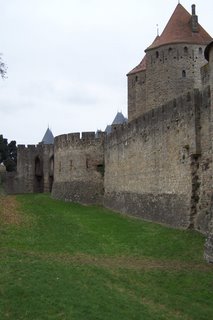 And as you approach the gate to the town you might be wondering about the welcome you would receive.
And as you approach the gate to the town you might be wondering about the welcome you would receive.
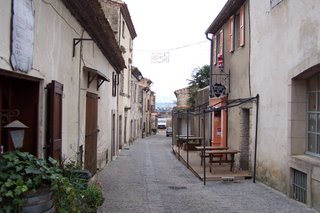
If you were allowed to enter the gate to the town a sight like this would greet you.
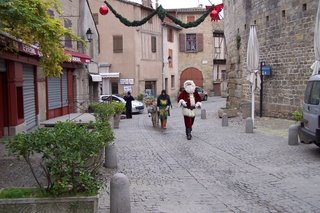 If it were near Christmas you might even meet Carcassonne’s Père Noël and his servant Pierre with his donkey.
If it were near Christmas you might even meet Carcassonne’s Père Noël and his servant Pierre with his donkey.
Or you might see this restaurant.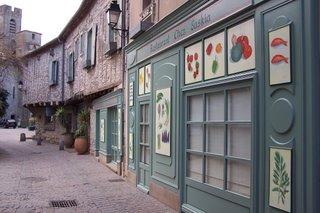

And we thought she was diligently working in the Langley Campus Admissions Office of Kwantlen University, not running a restaurant in a medieval town.
But back to the past. Within the walls of the town are two major structures: the castle to which the inhabitants would retreat in case of attack and the cathedral – their spiritual retreat, except perhaps during the Inquisition.
 Once you have gained entry to the walled town, the castle has an entirely separate set of walls and defenses.
Once you have gained entry to the walled town, the castle has an entirely separate set of walls and defenses.
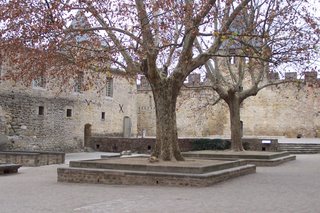
The castle was designed to be self-sufficient in water and stores of food.
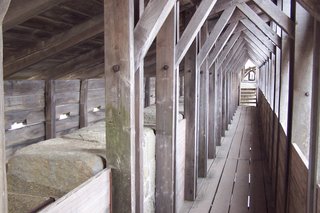 And the capacity to create enfilading fire on attackers.
And the capacity to create enfilading fire on attackers.

Located on a hill the castle and town had commanding views in all directions including the Pyrenees in the distance.
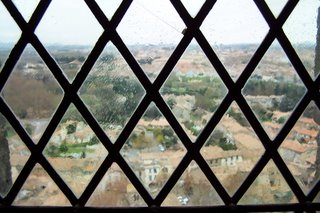 Imagine gazing through these clouded windows near sunset on a winter evening with the temperature outside just a few degrees above freezing and the drafts inside about the same bone chilling level.
Imagine gazing through these clouded windows near sunset on a winter evening with the temperature outside just a few degrees above freezing and the drafts inside about the same bone chilling level.
It wouldn’t have been much warmer in the cathedral which depended largely on the body heat of the parishioners.

The Cathedral of Saint-Nazaire and Saint-Celse harmoniously combines a Romanesque nave and Gothic transept. The earliest church was built sometime during the 6th century AD. In 925 the bishop transferred the Espicopal See from a church in the surrounding country to this site. It remained a cathedral until 1803 when the See was transferred to a church in the newer lower town.


We have seen Carcassonne's walled town, castle, and cathedral in the summer and now in the winter. The winter is much less crowded, almost deserted, and the town has much less of a commercial feel with many establishments closed for the season. Take your pick. But if you ever pass this way on your travels, take refuge within the walls of Carcassonne.
The walled town of Carcassonne between Toulouse and Montpellier holds 2500 years of history within its scarred towers. The site was first occupied by in the 6th century Before Christ by a Gaullish settlement, followed by an urban center in the Roman period. In the 3rd century AD occasional invasions and attacks resulted in the construction of the town’s fortified walls. By 435 it was a frontier town on the north of the Visigoth Empire. From 725 to 759 it was occupied by the Moors and subsequently passed into the control of the Franks. Its location between Barcelona and Toulouse resulted in its playing an important role in the 11th and 12th centuries, eventually becoming the principal defensive structure on the frontier between France and Aragon (Spain). Since 1997 it has been on the UNESCO World Heritage List.
 Imagine travelling in 1215 through the Pyrenees from Barcelona and sighting this in the distance.
Imagine travelling in 1215 through the Pyrenees from Barcelona and sighting this in the distance.
This might have been an olive grove below the impressive ramparts as you approach the town.
 And as you approach the gate to the town you might be wondering about the welcome you would receive.
And as you approach the gate to the town you might be wondering about the welcome you would receive.
If you were allowed to enter the gate to the town a sight like this would greet you.
 If it were near Christmas you might even meet Carcassonne’s Père Noël and his servant Pierre with his donkey.
If it were near Christmas you might even meet Carcassonne’s Père Noël and his servant Pierre with his donkey.Or you might see this restaurant.


And we thought she was diligently working in the Langley Campus Admissions Office of Kwantlen University, not running a restaurant in a medieval town.
But back to the past. Within the walls of the town are two major structures: the castle to which the inhabitants would retreat in case of attack and the cathedral – their spiritual retreat, except perhaps during the Inquisition.
 Once you have gained entry to the walled town, the castle has an entirely separate set of walls and defenses.
Once you have gained entry to the walled town, the castle has an entirely separate set of walls and defenses.
The castle was designed to be self-sufficient in water and stores of food.
 And the capacity to create enfilading fire on attackers.
And the capacity to create enfilading fire on attackers.
Located on a hill the castle and town had commanding views in all directions including the Pyrenees in the distance.
 Imagine gazing through these clouded windows near sunset on a winter evening with the temperature outside just a few degrees above freezing and the drafts inside about the same bone chilling level.
Imagine gazing through these clouded windows near sunset on a winter evening with the temperature outside just a few degrees above freezing and the drafts inside about the same bone chilling level.It wouldn’t have been much warmer in the cathedral which depended largely on the body heat of the parishioners.

The Cathedral of Saint-Nazaire and Saint-Celse harmoniously combines a Romanesque nave and Gothic transept. The earliest church was built sometime during the 6th century AD. In 925 the bishop transferred the Espicopal See from a church in the surrounding country to this site. It remained a cathedral until 1803 when the See was transferred to a church in the newer lower town.


We have seen Carcassonne's walled town, castle, and cathedral in the summer and now in the winter. The winter is much less crowded, almost deserted, and the town has much less of a commercial feel with many establishments closed for the season. Take your pick. But if you ever pass this way on your travels, take refuge within the walls of Carcassonne.


<< Home